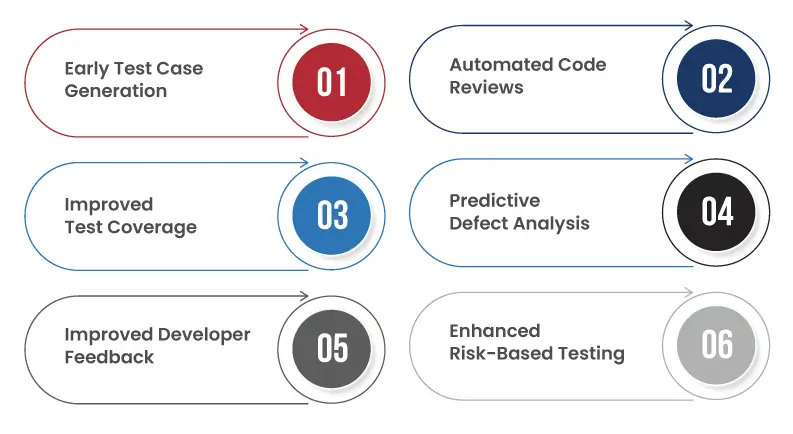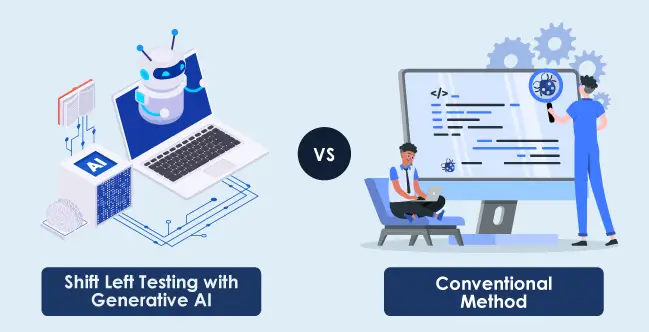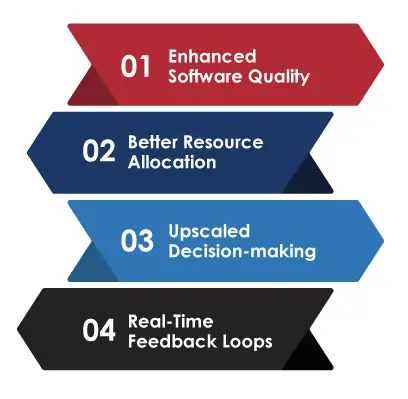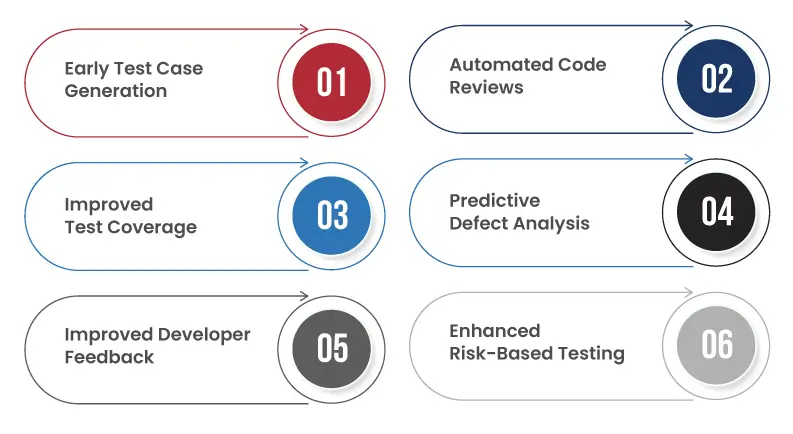- Role of Shift Left Testing with Generative AI in Modern QA
- Shift Left Testing with Generative AI vs. Conventional Method
- Business Benefits of Using GenAI for Shift Left Testing
- Why Partner with Tx for Shift Left Testing?
- Summary
It is common to experience release delays or failures and budget constraints in the software development and QA process. Almost every business might have encountered such a dilemma. Also, the demand to develop high-tech business-critical software within limited budgets and tight deadlines is causing the rapid adoption of new methodologies. The focus is on delivering greater business values in a short time. The best method facilitating this approach is “Shift Left Testing.”
As Generative AI continues to upscale almost every industry, it also shows promising outcomes in software testing. It is helping businesses optimize their workflows, redefine how teams collaborate, and drive efficiency and innovation. Leveraging shift-left testing with generative AI is helping teams achieve a higher level of excellence in software delivery.
Role of Shift Left Testing with Generative AI in Modern QA

The shift left approach changes how businesses handle software development and QA activities. Previously, teams relied on a waterfall approach, in which the developers and QA teams had their roles and responsibilities separately defined. Now, the shift left approach here refers to shifting the QA stage earlier into the SDLC process. This helps teams become more collaborative as they can share details as quickly as possible.
When combined with generative AI, shift left testing changes the modern QA approach. It allows businesses to transform their traditional QA processes as they achieve higher efficiency and deliver user-centric solutions tailored to market demands. Let’s take a close look at how shift left testing with generative AI is transforming quality assurance processes:
Early Test Case Generation:
GenAI can generate comprehensive test cases by analyzing requirements, acceptance criteria, and user stories in the early SDLC. It will ensure that the process aligns with shift left principles.
Automated Code Reviews:
Businesses can integrate generative AI into their CI/CD pipelines to automate the code review process. They can detect defects during the coding phase to reduce bug-fixing costs.
Improved Test Coverage:
GenAI can identify gaps in test coverage and suggest test scenarios to ensure robust testing.
Predictive Defect Analysis:
GenAI leverages historical data to allow businesses to predict where defects are likely to occur. This allows them to focus their QA efforts on high-risk areas.
Improved Developer Feedback:
Shift Left Testing benefits from GenAI’s real-time insights. It allows developers to fix code quality issues faster, reduce rework, and improve overall QA efficiency.
Enhanced Risk-Based Testing:
GenAI analyzes historical data to prioritize test scenarios, helping organizations focus on high-risk areas earlier in the development cycle.
Shift Left Testing with Generative AI vs. Conventional Method

Aspect |
Shift Left Testing with Generative AI |
Conventional Testing Method |
| Speed and Efficiency | Tests are automated early in the development cycle. It enables faster execution and quicker identification of issues, which reduces testing time and enhances overall efficiency. | Tests are typically executed later in the development process. This causes feedback delays and increases the time needed for the testing process. As a result, project delivery timelines are affected. |
| Accuracy and Precision | AI-driven tools analyze vast amounts of data with high precision. It ensures more accurate performance benchmarks and early bug detection and remediation. | Manual or scripted tests may miss edge cases and may not provide as precise or accurate results. This causes potential gaps in performance validation. |
| Test Coverage | Shift Left Testing ensures comprehensive test coverage by detecting performance issues early. It adapts quickly to evolving project requirements. | Conventional testing often misses some areas due to limited resources. This approach only focuses mainly on areas considered critical at the time of testing. Test coverage may be narrower. |
| Statistical Significance | Generative AI enhances statistical analysis by continuously learning and adapting, providing deeper insights and more reliable performance metrics over time. | Traditional methods rely on historical data and may lack the sophistication to gather statistically significant insights, often leading to less impactful results. |
Business Benefits of Using GenAI for Shift Left Testing

Leveraging GenAI for shift left testing would allow businesses to enhance their SDLC process and streamline their project life cycle. In return, it would bring the following benefits:
Enhanced Software Quality:
By shifting left and integrating GenAI, businesses can speed up the development process and remediate defects early, facilitating improved software quality and a quicker release cycle. It would also allow them to deliver new features/updates more frequently to their user base.
Better Resource Allocation:
Organizations can better utilize their dev and QA teams, which are the core of the development process. This will prevent bottlenecks and enable better resource allocation/utilization. In addition, businesses can identify and prevent any underlying issues early in the SDLC, which would be more cost-effective than doing it later on.
Upscaled Decision-making:
Organizations can improve their decision-making by analyzing metrics and collecting data by integrating the testing process early. This will facilitate a data-driven approach to continuous improvement and reduce the effort needed for bug fixing.
Real-Time Feedback Loops:
Generative AI assists with continuous testing by delivering real-time insights, ensuring feedback stays accurate and relevant. This approach allows teams to adapt quickly, facilitating a dynamic testing environment. By analyzing test results instantly, teams can refine strategies on the go—essential for fast-paced projects and cultivating ongoing improvement.
Why Partner with Tx for Shift Left Testing?

At Tx, we assist our clients in adopting Shift Left Testing practices, ensuring that quality is integrated from the start of the development process. By leveraging our AI expertise, we automate testing early in the lifecycle and embed continuous testing into the CI/CD pipeline. We help our clients identify issues proactively and enhance software performance. Our Shift Left Testing approach reduces time to market, cuts costs, and ensures higher software quality. This allows businesses to stay ahead in today’s fast-paced digital world. Our approach consists of the following solutions:
Early Test Automation:
We integrate test automation at the beginning of the SDLC, allowing for early detection of bugs and performance issues. We ensure your QA process works alongside development, minimizing delays and rework.
AI-Driven Test Generation:
Our AI-powered framework, Tx-automate, Tx-SmarTest, assists with test case generation and optimization. These tools continuously adapt to application changes, ensuring tests are relevant and aligned with current development needs.
Continuous Integration and Continuous Testing:
We integrate testing into your CI/CD pipeline, allowing tests to run automatically every time a new code is committed. This will offer your developers real-time feedback while they ensure that issues are identified and fixed immediately.
Proactive Risk Detection:
Our QA experts use Shift Left Testing principles to detect and address potential risks early. This reduces the likelihood of defects emerging through your SDLC while improving overall software quality.
Faster Time to Market:
By catching defects earlier and automating repetitive tasks, we speed up the development process, helping our clients release high-quality software early and with fewer delays.
Cost Efficiency:
With early bug detection and reduced rework, we minimize the cost of fixing defects at later stages of development.
Summary
Shift Left Testing with Generative AI transforms modern QA by enabling faster issue detection, improved collaboration, and higher software quality. Businesses can optimize their test coverage, accuracy, and resource efficiency by leveraging AI-powered tools. Shift Left Testing reduces project timelines, mitigates costs, and boosts decision-making through data-driven insights. Partnering with Tx enables you to seamlessly adopt Shift Left Testing, accelerate time to market, and improve overall software performance, ensuring long-term business success. Contact our QA experts now to know more about our AI-powered shift left testing expertise.
The post Shift Left Testing Meets GenAI Transforming QA or Just Hype? first appeared on TestingXperts.
Source: Read More


